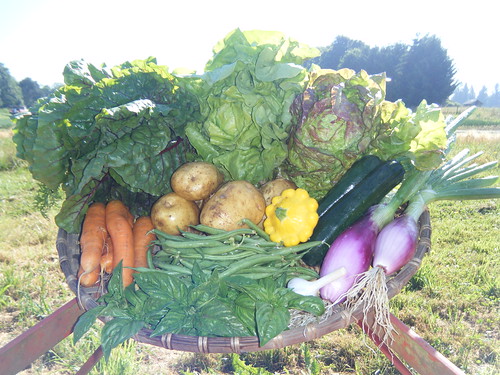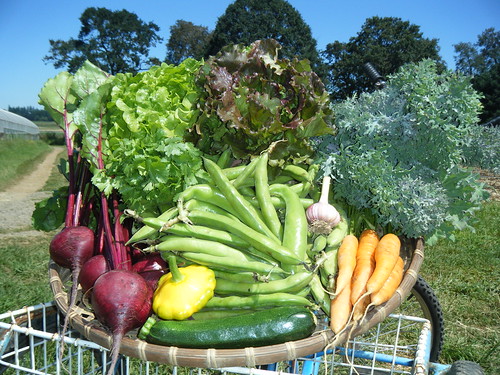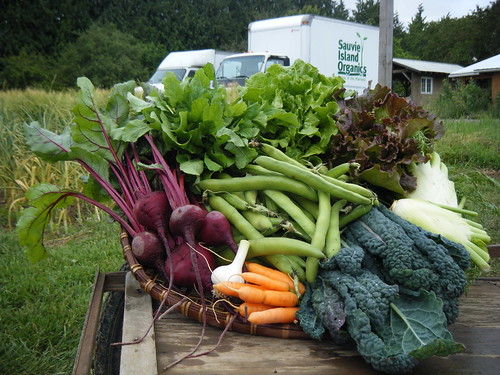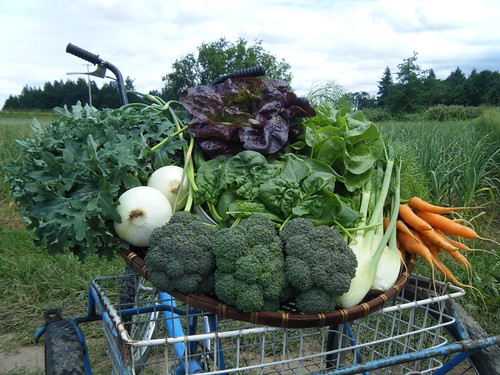
This Week’s Share
- Basil
- Beans, Green and/or Yellow
- Carrots
- Cucumbers
- Eggplant, Orient Express
- Garlic
- Lettuce
- Onions, Torpedo
- Summer Squash
Share Notes:
- Cucumbers: In addition the standard green slicing cucumbers and lemon cucumbers SIO traditionally grows, we are also trying out another lemon cucumber variety called Boothby. It is more elongated than the the spherical lemons cucumber you may be used to. You will see all these types of cucumbers in your share throughout their season.
- Eggplant: We grow two varieties of eggplant, a classic bell-shaped eggplant named Nadia and a long, slender, Asian-style eggplant named Orient Express. With this first distribution you will see the Japanese eggplant, with several distributions of both types in your share from now until the fall.
Come Join Us
The Annual SIO Potato Harvest Work Party and French Fry Feast is this Saturday, August 14th from 10am-2pm. Take a look at the schedule below and come join us for all or part of the day, even if it’s just for lunch.
This is a very kid friendly event, just make sure to wear farm field appropriate shoes and be ready to get dirty. Please bring a potluck dish to share, we’ll provide the fresh french fries.
Schedule of Events
- 10-12:30 spuds harvest
- 12:30-1pm farm tour
- 1pm-2pm potluck lunch
If you’re not quite sure about coming, check out video from the 2008 Potato Harvest Party and you’ll surely won’t be able to resist.
Recipes
Basil Recipe
Basil Pesto
Recipe from Francesca Benedetti (CSA Coordinator at SIO)
2 cups basil, large stems removed
3-4 cloves garlic
1/3 cup toasted pine nuts, cashews, sunflower seeds, or pecans
1/4-1/2 cup olive oil (how much depends on your preferred pesto consistency)
1/2 cup grated Parmesan cheese
1 tablespoon lemon juice (optional)
salt and pepper to taste
Put basil and garlic in a blender or food processor and pulse until coarsely chopped. Add the toasted nuts and pulse a few more times. Now pour the olive oil in relatively slow with the blender processor going until a paste is formed. Add the Parmesan cheese and continue adding oil (up to 1/2 cup) until your desired pesto consistency is achieved. Add alt and pepper to taste. You may also add in 1-2 tablespoons lemon juice near then end for a more tangy flavor Makes approximately 1 cup. Great on pasta, sandwiches, vegetable dishes, corn on the cob, toast, and many more things.
Cucumber Recipe
Jicama and Cucumbers with Chile and Lime
From Vegetarian Cooking for Everyone by Deborah Madison
Note: Originally native to Mexico, Jicama is a large tuber covered with a papery tan skin. Its appearance doesn’t even hint at its bright white flesh, which is crisp, juicy and sweet.
½ small jicama (about 8 ounces)
2 cucumbers
Grated zest and juice of 2 limes
1 jalapeno chile, seeded and finely diced
Salt
Peel the jicama and cut into bite-sized cubes. Peel the cucumber if that is your preference; otherwise score the skins with a fork, then quarter them lengthwise and dice into cubes. If they’re very mature, scrape out and discard the seeds first. Toss everything together and taste for salt and lime. Refrigerate until very cold, or serve right away on little plates with toothpick or small forks. Serves 4 to 6.
Eggplant Recipe
Roasted Summer Vegetables
From Simply in Season by Mary Beth Lind and Cathleen Hockman Wert
Note: This is a versatile summer recipe that can be used as a side dish, main dish, or salad. Be sure to make enough for leftovers to put on pizza. Try a variety of vegetables through out the summer, including almost anything from your share this week or potatoes, peppers, tomatoes, mushrooms, corn, etc.
8 to 10 cups fresh vegetables (try summer squash, eggplant, onions, beans, and carrots from this week’s share)
Cut all vegetables into bite sized pieces for even cooking time (i.e. thinly slice carrots, but chop summer squash into larger chunks). Toss with one of the seasoning options below. Then spread seasoned vegetables in a thin layer on a baking sheet and bake in preheated oven at 425˚F for 20 minutes. Stir occasionally.
For a Main Dish: Serve over cooked penne pasta, wild rice, or couscous and top with freshly grated Parmesan cheese.
For a Salad: Cool vegetables (or use the leftovers) and add 2 cups diced tomatoes, 3 ounces feta cheese, and additional vinaigrette dressing.
Kabab Variation: Soak wooden skewers, if using, at least 30 minutes in water to prevent scorching. Thread a variety of season vegetables on each skewer, keeping mushrooms separate as they will cook faster; carrot chunks and small whole potatoes should be boiled a few in advance. Grill over medium heat until vegetables are tender.
Seasoning One:
3 tablespoons fresh basil, chopped
2 tablespoons fresh cilantro, chopped
1½ tablespoons fresh thyme, chopped
1 tablespoons olive oil
½ teaspoon salt
½ teaspoon pepper
1 to 4 cloves garlic, minced
Seasoning Two:
1 tablespoon olive oil
1 teaspoon chili powder
½ teaspoon salt
¼ teaspoon thyme
1/8 teapsoon pepper
Seasoning Three:
¾ cup Italian dressing or vinaigrette dressing
Seasoning Four:
4 cloves garlic, minced
1/3 cup olive oil
2 tablespoons each fresh thyme, oregano, and basil, chopped
2 tablespoons balsamic vinegar
1 tablespoon Dijon mustard
½ teaspoon salt
¼ teaspoon pepper
Chef’s Corner: August
In addition to the crops SIO grows for our CSA program, we also grown and sell produce to 30-40 Portland area restaurants and kitchens, and this season at SIO we are partnering with some of those restaurants for some culinary inspiration. We have been picking the brains of some of the areas most talented chefs and restaurant owners, and have asked them to provide us with recipes and general cooking techniques based on the crops that you receive in your shares. Out at the farm we crop plan separately for both our CSA program and restaurant sales, so you don’t have to worry that part of your share may be going the restaurant down the street. For the month of August our featured restaurant is Wildwood, located in Portland’s beautiful Northwest neighborhood, near Forest Park’s 17-mile long Wildwood Trail.
Paul Kasten, Sous Chef at Wildwood Restaurant & Bar
Founded in 1994, Wildwood is an American restaurant and bar bringing you the best the Pacific Northwest has to offer. Our menus are inspired by the fresh seasonal produce that we are so fortunate to have throughout the region. The complexity of our dishes comes from the depth of flavor in the ingredients, most which are found within miles of the restaurant.
Local ingredients keep us firmly rooted in our rich Oregon soil. Wildwood supports local farms which practice environmentally sound agriculture and sustainable farming, and market driven menus always showcase our local farms and purveyors. We have been working with Sauvie Island Organics for many years now, and they remain one of our favorite farms. It is always a privilege to work with whatever fantastic produce they have to offer.
I have assembled a menu for a summer barbecue highlighting some of my favorite products available this month from Sauvie Island Organics. These four dishes are meant to be served family style and will make a satisfying meal for six to eight people.
The cured salmon should be started about five days in advance to allow additional curing time if needed. It will hold well in the refrigerator for several days after it is finished.
The chicken should be brined the day before.
The chickpeas should be soaked two days before and cooked the day prior to the barbecue.
The focaccia croutons for the bread salad can be toasted the day before and stored in a sealed container until needed.
As far as the actual grilling goes, this is arranged so that you can cook three dishes on your grill with one firing, making it convenient for those using charcoal. The carrots and eggplant will require high heat, while the chicken, which cooks last, will need to grill longer over lower heat.
HOME CURED OREGON CHINOOK SALMON GRAVLAX
shaved torpedo onion, cucumber, lime yogurt, chile and arugula
gravlax:
1 lb very fresh local Chinook salmon fillet
4T granulated sugar
3T kosher salt
1 bunch dill, large stems removed
Remove any pin bones from the salmon. Rinse and pat dry with a paper towel. Evenly coat the fish with a mixture of the salt and sugar. Lay out a sheet of plastic wrap with half of the dill spread out on it. Lay the salmon on top. Cover salmon with the remaining dill and wrap tightly. Lay flat in a Tupperware container or baking dish and refrigerate for three days. At this point the salmon should be uniformly firmer from the cure. If some spots still feel like raw, fresh fish, apply the same amount of salt and sugar again and cure for another day or two. When the fish is fully cured, rinse it, pat it dry, wrap it tightly with plastic wrap and refrigerate it until needed. Thinly cut two or three slices per person. Lay them out on a platter and top with the following ingredients in the order listed:
lime yogurt
½ c thinly shaved torpedo onion
1 cucumber, peeled and seeded, sliced thinly
1 serrano pepper, seeded and minced
1 handful arugula leaves
lime yogurt:
Whisk together ¼ c good quality store bought or home made yogurt, juice and zest of one lime, and 1T good extra virgin olive oil.
MARINATED GRILLED EGGPLANT
2 lb Japanese eggplant, sliced lengthwise ¼” thick
1c good olive oil
6 cloves garlic, minced
¼c parsley leaves, torn
1 lemon, quartered
Brush eggplant with a light coat of olive oil and season lightly with kosher salt. Prepare a very hot grill. Lay the eggplant on the grill and place a baking sheet on top. Cook until nicely charred on one side and almost cooked through. Remove and place in a bowl. Combine remaining olive oil, garlic and parsley. Coat grilled eggplant with oil mixture and allow to marinate at room temperature while you cook the carrots and chicken. To serve, remove eggplant from marinade, squeeze the lemon over it and season liberally with coarse sea salt and freshly ground black pepper.
GRILLED CARROT AND CHICKPEA SALAD
pine nuts, shaved torpedo onion, cilantro, feta and lemon vinaigrette
1 lb. carrots, peeled and sliced in half lengthwise
½c dried chickpeas
3 bay leaves
½c torpedo onion, thinly shaved
½c cilantro, coarsely chopped
½c crumbled feta cheese
¼c pine nuts, toasted
¼c lemon juice
Zest of two lemons
2 cloves garlic, minced
¼c good olive oil
Vinaigrette:
Whisk together lemon juice, zest, garlic and olive oil. Add kosher salt to taste.
Chickpeas:
Soak chickpeas in cold water in the refrigerator overnight. Put them in a saucepan with one quart of water and the bay leaves. Bring to a simmer and cook until chickpeas are tender. Remove from heat, stir in 2T kosher salt, and let stand in the salted water overnight in the fridge. The day of the barbecue, drain and rinse the chickpeas and let them come to room temperature.
Salad:
Brush carrots lightly with olive oil and season with kosher salt. Place on a hot grill with a baking sheet on top. Cook until carrots are nicely charred on one side and cooked but not soft. Remove and cut carrots into bite sized pieces. Leave out at room temperature until ready to serve. Toss with chickpeas, onion, cilantro, feta, pine nuts and vinaigrette. Season with kosher salt to taste.
GRILLED WHOLE CHICKEN AND PANZANELLA
chicken/brine:
½ gallon water
6 oz kosher salt
4 oz granulated sugar
1 bulb garlic, unpeeled, cloves smashed with the side of a knife
2T fennel seed, toasted
1T chile flake
4 lb ice
1 3½ lb. pasture raised chicken, butterflied (spine removed with knife or shears)
Combine water, salt, sugar, garlic and spices. Bring to a simmer for two minutes and whisk to dissolve salt and sugar. Pour over ice in a container large enough to accommodate the chicken. Brine overnight in the refrigerator. Remove from brine, pat dry and rest chicken at room temperature for one hour before grilling. After grilling the eggplant and carrots, allow the grill to cool to medium-hot, brush the grates and the chicken with olive oil, lay the chicken flat on the grill, skin side up and put the lid on. After roughly twenty-five minutes, flip the chicken to brown the skin side. Remove when a thermometer inserted in the thickest part of the thigh reads 170 degrees. At this point the breast should be at about 160 degrees. Remove from grill and tent with foil for ten minutes before serving on a platter on top of the panzanella.
Panzanella (bread salad):
1 loaf focaccia, approximately 6″x8″
½ lb. tomatoes, peeled, seeded and grated on a box grater
½ lb. tomatoes, diced
¼c zinfandel or other good red wine vinegar
1c good olive oil
4 cloves garlic, minced
¼c shallot, minced
Juice of one lemon
1 cucumber, peeled, seeded and diced
1c basil leaves, torn into large pieces
Vinaigrette:
Whisk together grated tomato, vinegar, ½ cup olive oil, garlic, shallot and lemon juice. Add kosher salt to taste.
Salad:
Cut focaccia into 1″ cubes. Toss with remaining ½ cup olive oil and a pinch of kosher salt. Toast on a baking sheet in a 400 degree oven until crisp outside, but still soft on the inside. Toss with vinaigrette about five minutes before serving to allow the bread to soak in some of the moisture. When ready to serve, toss with the remaining ingredients.











